Left untreated, dental caries can cause pain, infection and even tooth loss. Early detection of dental caries is crucial to prevent further progression. Traditionally dental caries are detected through dental examinations. However, with advancements in technology, dental caries detectors are now available which have made caries detection more convenient and objective.
Optical Detectors
The most common type of dental caries detectors available are optical detectors which use light technology to detect lesions. These include devices like:
– Laser fluorescence detectors: These use laser fluorescence technology to detect dental caries. A laser light is directed onto the tooth surface, and the fluorescence from healthy and carious enamel is measured. Depressions in the enamel caused by demineralization due to caries absorb and scatter the laser light differently from sound enamel, allowing the device to detect early-stage caries. Laser fluorescence has been shown to detect up to 80% of cavitated lesions. However, non-cavitated lesions are detected with lower accuracy of around 50-60%.
– Fiber-optic trans-illumination: This uses fiber-optic bundles and light emitting diodes to transmit light through the tooth. Carious lesions will appear darker since carious enamel scatters light more than healthy enamel. This method is highly accurate for detecting cavitated lesions but has lower accuracy for non-cavitated caries.
– DIAGNOcam: Dental caries Detectors device uses laser-fluorescence, fiber-optic trans-illumination and digital imaging technology to capture both still photographs and videos of suspected lesions. The images are presented on a monitor and analyzed using special software for accurate caries detection. Several studies have found DIAGNOcam to perform on par with or better than visual inspection alone.
– Digital imaging fiber-optic trans-illumination: With this method, images captured during fiber-optic trans-illumination are transferred to a computer and analyzed by trained examiners. Several devices using this technology like DIFOTI and Canary System have shown high sensitivity and specificity for caries detection.
Radiographic Detectors
For detection of interproximal and root caries that may not be visible during regular visual examination, radiographic methods are commonly used. Some radiographic caries detection devices include:
– Digital radiography: With advances in technology, conventional X-ray films have now been replaced by digital radiography systems in most dental practices. Digital radiographs provide enhanced contrast and allow magnification of suspicious areas for improved caries detection. They also eliminate the need for chemical processing of films. Several studies have reported digital radiography to be as accurate as conventional films for detection of interproximal caries.
– Bitewing radiography: Taking bitewing radiographs is considered the standard of care for detecting interproximal caries between teeth in adults. Multiple bitewing views from different angles may be required to detect lesions on all tooth surfaces. However, its accuracy depends on the expertise of the clinician and radiographic technique errors are possible.
– Visualization voxel-based imaging: Emerging technologies like dental cone-beam computed tomography scans are being evaluated for caries detection. Although not widely used currently due to high radiation doses, visualization voxel-based imaging systems allow three-dimensional volumetric rendering of teeth from CT scans and may detect caries earlier compared to 2D radiographs. Further research is still needed regarding their efficacy.
Biomarker Detectors
Advancements are also being made in developing caries detectors that analyze biomarkers associated with the caries process:
– Bacteria detection: Commonly implicated bacteria like Streptococcus mutans play an important role in the initiation and progression of caries. Devices are being researched that can detect these cariogenic bacteria in dental plaque and saliva samples using molecular techniques like polymerase chain reaction (PCR). Detection of these bacteria may aid caries risk assessment.
– Proteomic analysis: Certain salivary proteins and enzymes have been found to have diagnostic value as biomarkers for caries. Studies are exploring the potential of protein microarray chips and mass spectrometry analysis of saliva to detect differentially expressed proteins associated with dental caries. This could provide an objective biochemical method for caries detection.
– Metabolite analysis: Small molecule metabolites produced during the caries process may serve as diagnostic biomarkers. Devices measuring salivary or plaque levels of metabolites like lactic acid are being investigated. Combining metabolite analysis with detecting bacteria may enhance caries detection accuracy.
Clinical Effectiveness and Future Potential
Various clinical trials and studies have validated the effectiveness of different Dental Caries Detectors discussed in this article. Optical methods like laser fluorescence and fiber-optic trans-illumination are highly accurate in detecting cavitated lesions. While their ability to detect non-cavitated lesions early is still evolving, they provide an objective quantitative method compared to just visual examination. Radiographic detectors remain essential for detecting interproximal caries but digital radiography improves their diagnostic value. Biomarker-based detection holds promise for the future but is currently limited to research applications. With ongoing technological advancements, dental caries detectors will continue to offer dentists improved sensitivity and convenience for early caries detection. This will help shift treatment from restoration to prevention and remineralization, benefiting patients in the long run.
*Note:
1. Source: Coherent Market Insights, Public sources, Desk research
2. We have leveraged AI tools to mine information and compile it

